Page 1 of 3
Alternatives to the Sierra caliper for Trackerjack brakes.
Posted: Fri Mar 11, 2016 11:15 pm
by tom16v
So, I was trying to find some Sierra calipers complete with Carriers for my Trackerjack conversion and finding it very difficult to source a pair.
After asking around I found it rather confusing as to which units from more recent Ford models might work.
I ended up buying 3 sets of calipers and have mocked them up and thought I would share the results.
The first ones I bought were from an early (pre2000 I think) Puma 1.7.
The second were from a Street/SportKA.
Both of these sets I was then led to believe were designed to fit the larger 258mm diameter disc rather than the 239mm diameter unit used in the trackerjack kit. However, both did have the larger 54mm diameter piston as per the Sierra caliper.
I then bought a set of KA 1.3 calipers from a 2007 car with vented discs. This car had the smaller disc for certain, but used a smaller 48mm piston in the caliper.
I didn't want to use the smaller piston caliper, but maybe I could use the carrier with a large piston caliper from one of the other sets?
The following is what I found.
Puma 1.7 Carrier was actually for the 239mm disc, so these calipers will fit and work as per the Sierra unit. I think they went to the larger disc after 2000 though.

There is the puma carrier over the disc. The 1.3 KA one is identical, but the Sport/StreetKA one is too tall as it is designed for the bigger sweep of the larger disc.
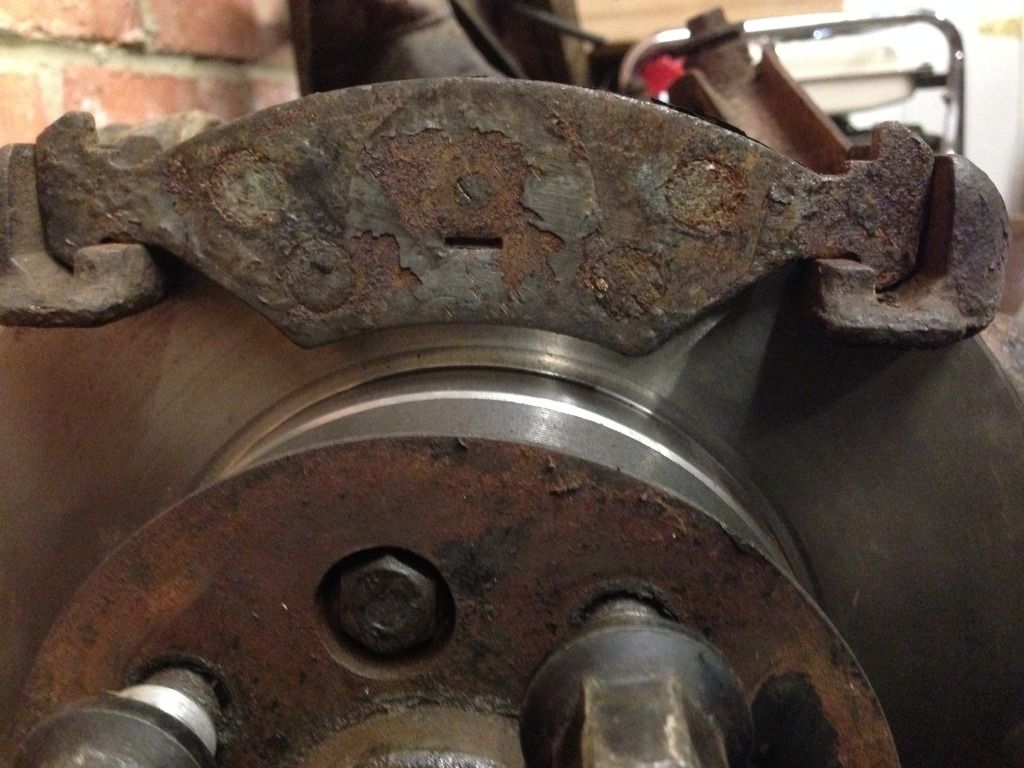
There is a puma/KA 1.3 pad in the carrier. Again, they are both identical.
You can see that there is quite a bit of the discs swept area that is missed by this pad.

There is a pad from the SportKA, ie designed for the larger 258mm disc in the puma carrier.
It fits perfectly on the outside and covers the discs swept area exactly.

Hmm. So the inner pad doesn't quite fit the carrier perfectly.

It just fouls the pad corners as in the picture above.
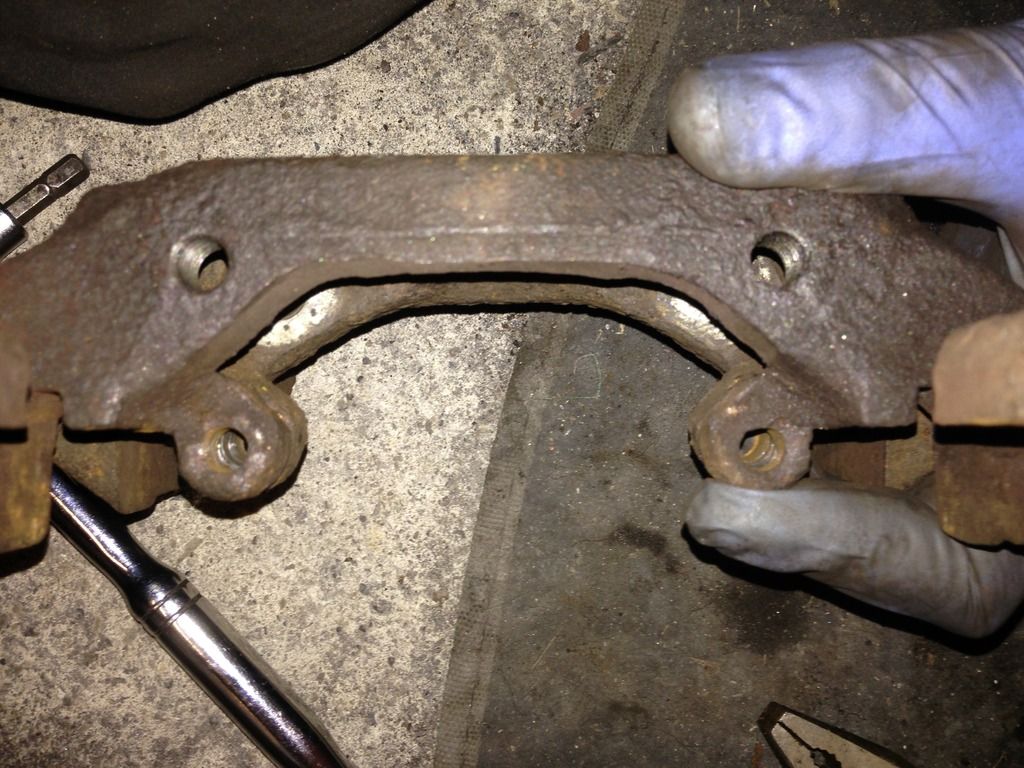
Slight dressing with the grinder and...

Larger caliper pads fit the small disc carrier and get all the discs swept area. My estimation is a pad area of 38cm2 for the puma pad and 41cm2 for the larger SportKA pad, per pad. This should give even better brake force as there is more pad area, but also better heat dissipation because more of the discs swept area is used to brake on.

You can see in the pictures that the Sport KA pads have a lump in the centre of the pad backing. This is what holds the pad into the carrier in this system rather than the pad locating at the edge of the caliper body. This means that you have to use the SportKA caliper body with these pads as the body has a ditch in the middle of the casting to locate this part of the pads. The puma caliper is uniform as can be seen in the photos below.

Puma caliper.
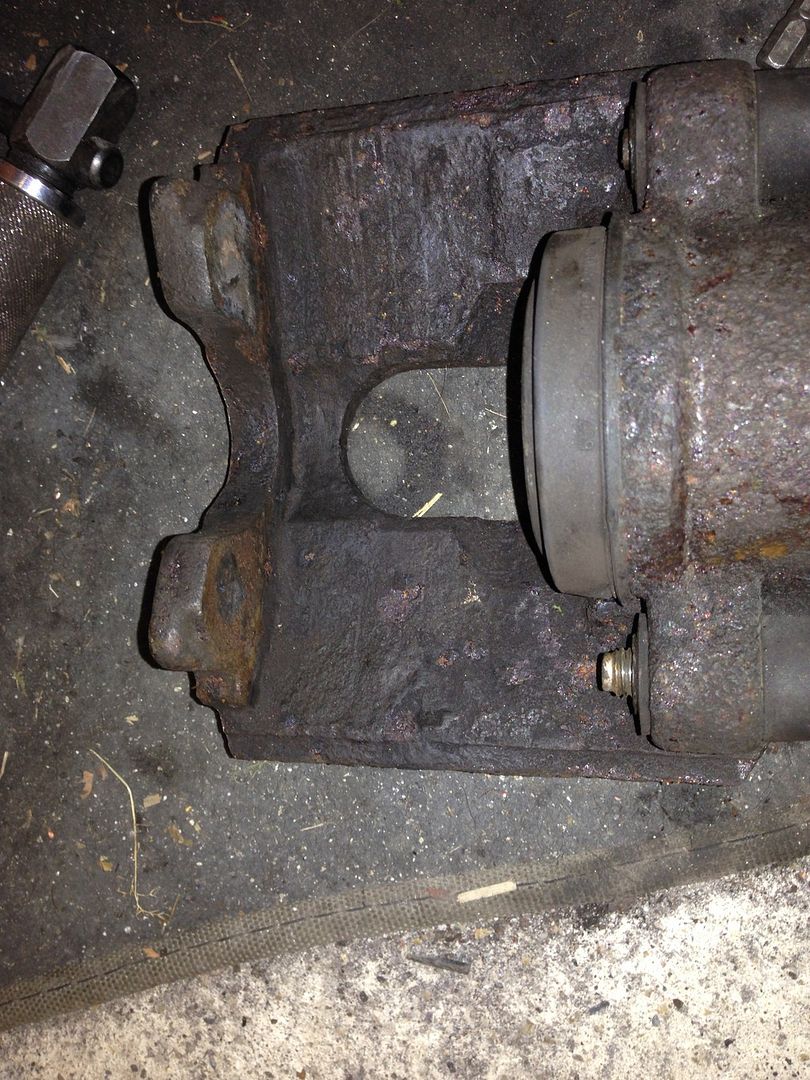
SportKA caliper with ditch to locate larger pads.
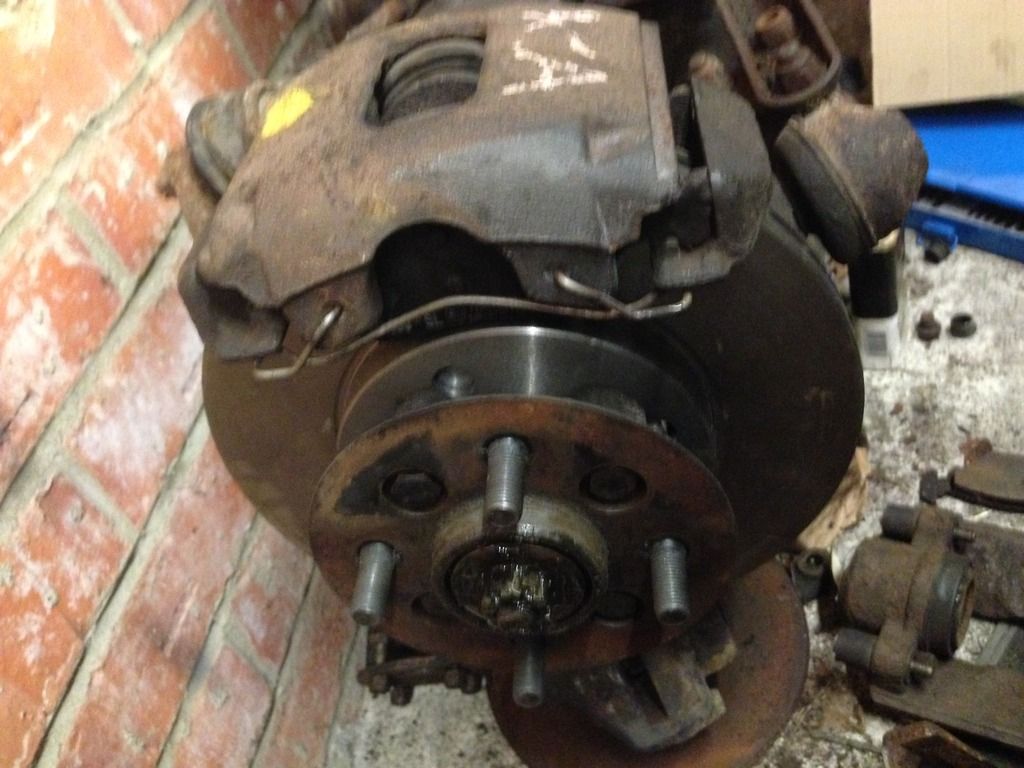
KA 1.3 carrier modified to take larger SportKA pads with SportKA 54mm piston caliper body all fitted up.


I am going to build up this set up for my fast road / track day car, but I could have just used the puma calipers as they come.
I hope this is useful for those wishing to use John's excellent brake upgrade, but struggling to find the right caliper, as I was.
Cheers all
Tom.
Re: Alternatives to the Sierra caliper for Trackerjack brake
Posted: Sat Mar 12, 2016 9:33 am
by tony g
Nice write up Tom , well done for sharing

Tony
Re: Alternatives to the Sierra caliper for Trackerjack brake
Posted: Sat Mar 12, 2016 1:17 pm
by GrahamFountain
Tom, is there any chance of some pictures that would allow me to estimate where the centroid of the pad sits on the disc, relative to the centre of the hub, so I can get a rough value for the change in brake effort? I've got the data for the std pads from another thread somewhere, and a spread sheet to do the calcs. I admit I don't know that the pressure centre and pad centroid necessarily coincide, but I'm guessing that the change in one, as a ratio, should be about the same for the other.
If it is possible, I'd need a square on picture of the pad and the hub, with the pad in its proper place, but upside-down (back-to-front), on the disk. It would be best taken from as far back as possible and zoomed in to just pad, calliper, and hub - to reduce parallax problems. Picture 2 is nearly there: mostly needs a bit more coverage and be taken from a fair bit further out along the centreline of the stub.
What I'd be looking for is an upgrade for a road car to take proper advantage of more modern tires, but without having to reduce the effort from the back brakes to keep the same safety margins as a std car. I imagine many other road car owners wouldn't mind vented discs either - even though they don't, on their own, improve brake effort, just delay fade. I reckon what's right for a road car on better tires is only about 10 to 15 percent more front effort at the front. I already did the figure for the upgrade in piston area for the Sierra callipers, which is 26.5 percent more from the 54 mm pistons. Assuming that the pressure centre moves about the same as with the Sierra as well, it's another 21 percent, giving a total of 53 percent more brake effort at the front.
So this is still probably more of an upgrade than would suit a road car - without you have to add a means to manually re-balance the front and rear brake effort and then play with it till it's right (and hope you covered all eventualities). However, it's possible the 48 mm piston callipers you mention, on a larger, vented disc will do it. Again, assuming it's the same movement in pressure centre as I estimated for the Sierra calliper, 20 percent, it's only a little bit more than I'm looking for, and very possibly not too much. It should also have no effect on peddle length.
I guess the issue of whether 20 percent more brake effort at the front, and better tires, makes the std back brakes a bit strong on a road car, i.e. moves the actual brake balance too close to the perfect balance, is a suck it and see job. I'd need to look at the calcs, but I think it wants about 5 percent less piston area to compensate the back brakes for 20 percent more at the front, and keep the safety margins in brake balance about the same. And I'm not sure 5 percent is worth worrying over.
If it is a problem then maybe it's possible to do something like TriumphTune recommended when upgrading the front brakes on the TR7 and TR8s, and fit slightly smaller diameter rear pistons. Would anything from an 1850 or 1500, etc., give that small a change in area, and be made to fit the sprint back drums?
Graham
Okay.......
Posted: Sat Mar 12, 2016 2:26 pm
by sprint95m
Yet again I am loathe to enter this, other than to say
the wheel cylinders from Sprints and 1850s are interchangeable.
Ian.
Re: Okay.......
Posted: Sat Mar 12, 2016 2:46 pm
by GrahamFountain
sprint95m wrote:Yet again I am loathe to enter this, other than to say
the wheel cylinders from Sprints and 1850s are interchangeable.
Ian.
But are they the same diameters?
Re: Alternatives to the Sierra caliper for Trackerjack brake
Posted: Sun Mar 13, 2016 9:35 am
by trackerjack
Cor good work Tom.
There is no shortage with Sierra calipers as these are widely used on Westfield/Caterham/Robin Hood cars.
However there is a shortage of the slider brackets that these calipers fit on hence required second hand.
There is at least one car out there that has KA brakes on it as I made one up with the 48 mm caliper about 5 years ago and sold on Flea.
Re: Alternatives to the Sierra caliper for Trackerjack brake
Posted: Sun Mar 13, 2016 10:55 am
by tom16v
Thanks John
Your kit is excellent. It all fits up a treat and I can't see how you could get anything better under a Sprint wheel.

Firstly........
Posted: Sun Mar 13, 2016 11:19 am
by sprint95m
GrahamFountain wrote:sprint95m wrote:Yet again I am loathe to enter this, other than to say
the wheel cylinders from Sprints and 1850s are interchangeable.
Ian.
But are they the same diameters?
No, the Sprint wheel cylinder has a bigger bore.
Just to be clear, it is the Dolomite 1850 '72-'75 we are talking about.
Ian.
Re: Alternatives to the Sierra caliper for Trackerjack brake
Posted: Sun Mar 13, 2016 11:28 am
by tom16v
Hi Graham
I will try and get the photo you request this evening.
This debate that you explain still very much interests, but confuses me I am afraid.
I have experienced the rear wheels locking on a Sprint during hard braking at motorway speeds due to a stuck load sensing valve. I have never been so frightened by an event in my motoring career. This is a situation I want to avoid at all costs.
I have also driven 100000 miles in a mk3 Polo GT. This had the front drag struts made up of the anti roll bar and then located into the track control arm with a very sloppy bush. Consequently the castor and toe all went completely to pot under hard braking and it used to lock the front wheels with worrying ease. Although far from ideal, this was much safer than the rear lock on the Dolly, as I always continued to face in the direction of travel when I overcame grip and could then take alternative avoiding action if needed.
I am not a qualified engineer and have only A level physics to call on, so need this explaining in lay mans terms if possible please.
The way I understand the physics is as follows.
Increasing the piston area, pad area and brake force centre diameter will all increase the effectiveness of the front brakes for a given fluid pressure in the system. Therefore, for a given front brake force there will be less fluid pressure, so less rear brake force applied by the otherwise standard rear brakes.
As my car is otherwise standard, the process of weight transfer and the effect this has on grip ratios front to rear should be the same as it was when Triumph designed the system. So the rears should be less likely to lock, but provide less of the brake effort during any given stop?
I can see how this may cause the brakes to be less effective in the perfect road conditions as the fronts may get to the limit of their grip and lock, at a pressure when the rear brakes are not close to locking and are therefore wasting some grip potential from the rear tyres.
However, the way I see it, this pushes the balance towards the situation with the Polo rather than the situation with the Sprint with the seized bias valve?
As road conditions are rarely perfect and I have experienced rear lock in a road situation with a Standard Sprint I would think that this is a good thing for a road car.
I have only driven 1 car with the Trackerjack kit and when I first hit the brakes a little hard it was definitely the fronts that locked.
The main reason for me to fit this kit is for heat dissipation though. A standard Sprint with modern pad material will start to fade at 20mph during 1 hard stop from 90mph. I managed 2 laps of Donnington's heritage circuit before they were faded completely and I came off the track on the third lap to brakes on fire. This is what I hope to avoid with the vented upgrade and the larger pad and disc swept area for heat soak.
Thanks for your input
Cheers
Tom.
Re: Alternatives to the Sierra caliper for Trackerjack brake
Posted: Sun Mar 13, 2016 4:45 pm
by GrahamFountain
Tom, Thanks for being willing to get the photos.
I could write the equations down in a trice, but explaining it simply, in words will be a problem for me. I'll have a go and post later.
Ian, Do you know the diameters of the two sets? And how available are these 72-75 1850 cylinders?
Graham
Re: Alternatives to the Sierra caliper for Trackerjack brake
Posted: Sun Mar 13, 2016 6:40 pm
by tom16v
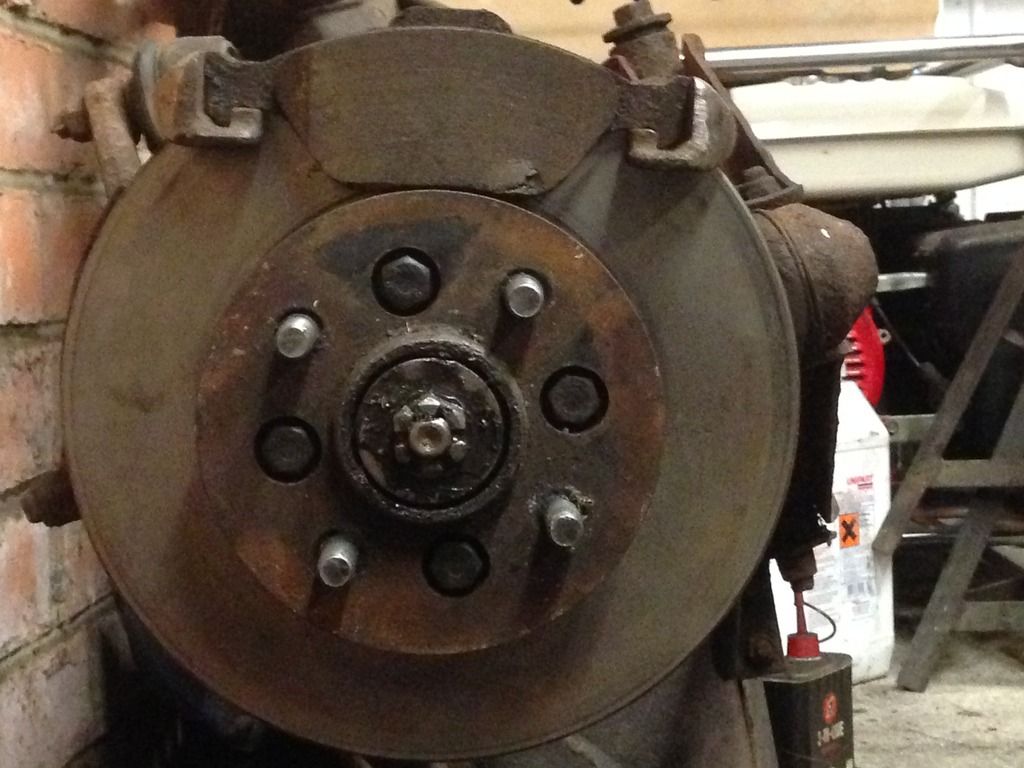
I think that is the photo you requested Graham?
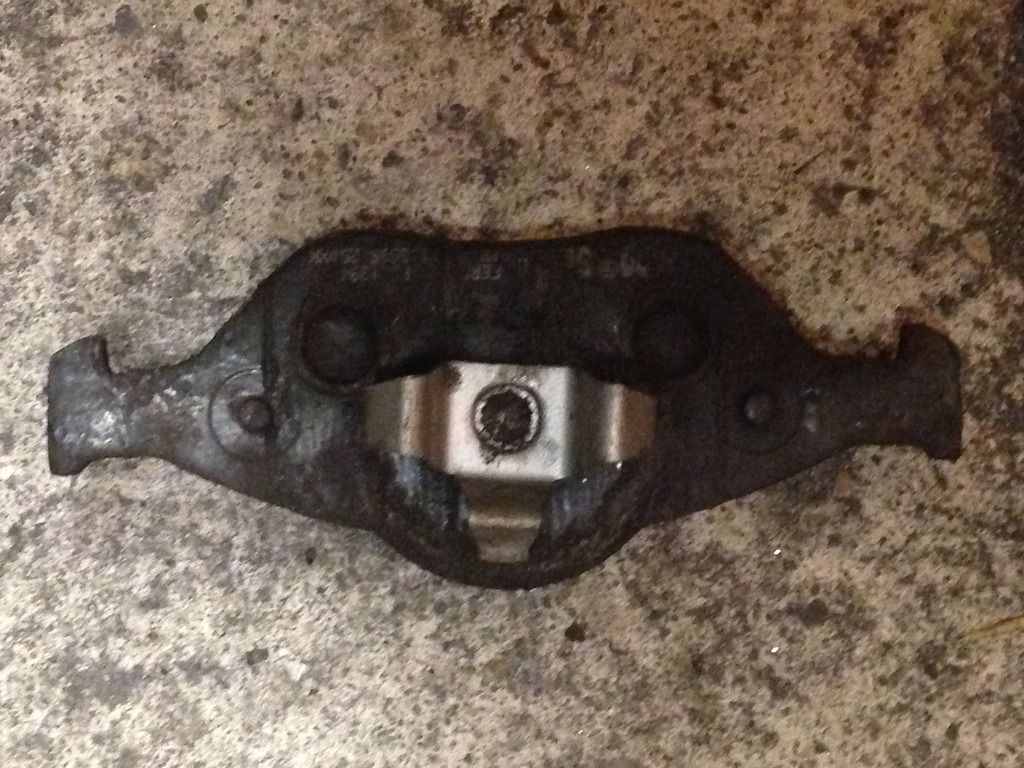
That should be one of the rear pad showing the piston centre on the pad. This is outboard of the centre line of the pad itself.
I hope that is helpful.
Cheers
Tom.
Re: Alternatives to the Sierra caliper for Trackerjack brake
Posted: Sat Mar 19, 2016 10:48 am
by GrahamFountain
Re: Alternatives to the Sierra caliper for Trackerjack brake
Posted: Sat Mar 19, 2016 6:00 pm
by trackerjack
We have been here before and I care not for theory as fact has shown that removal of the loads sensor seems to work when using my brake conversion as I never ever had a rear lock up in the 13 years of driving in all conditions not only track work.
Back in the 80's I was a member of the TR Register and we once had a talk from an accident expert from the police. It was one of the most informative talks I have heard as he had attended many accidents/driver fails and one demo he showed was a dinky toy car that he locked the wheels of and let it loose on an angled board. When he locked the front wheels the car slid straight and when he locked the rears it spun when released, just as Tom16v has described.
Also back still further in 1966 I was the Wessex cyclo cross champ which involves racing cycles in mud, snow and other slippery surfaces and I always used the front brake hard and only gentle rear braking.
No theories for me, just facts.
Re: Alternatives to the Sierra caliper for Trackerjack brake
Posted: Sun Mar 20, 2016 8:56 am
by GrahamFountain
tom16v wrote:I am not a qualified engineer and have only A level physics to call on, so need this explaining in lay mans terms if possible please.
I've had a go at an explanation of what changes the effectiveness of the brakes, if not exactly in layman's terms, at least with nothing above 'A' level physics involved:
The increase in brake effort for a front brake upgrade is simply the increase in piston area multiplied by the increase in the distance between the hub and the pressure centre of the pad, i.e. the increase in force on the pad, for a given hydraulic pressure, times the increase in leverage.
The area of tha pad isn't relevant to the increase in effort (Amontons' second law), and only affects the way the pad heats up, for a given amount of braking effort, and thus only affects the way the brakes fade – bigger pads will fade less quickly. Similarly, venting the discs only affects the way the disc and the pads heat, and thus reduces fade, but does not change the brake effort (well it will reduce it very, very slightly in normal use, because the pads will run a bit cooler and thus have a very slightly lower coefficient of friction; up to the point where the unvented ones fade). The effect of moving the pressure centre further out is only the increased leverage, even though the pads are running on a faster part of the disc (Coulomb's Law of friction).
It is also true that bigger pistons affect the "length" of the pedal, i.e. how far you have to press the pedal to get the same pressure on the pad, but that has no significant effect on ratio between the hydraulic pressures at the front and rear brakes once everything has stopped moving. I do need to look closely at how the load sensing valve works, and if anyone has a proper description anywhere, that would be interesting. I know how the brake balance pressure reducing valve on the TR7 works, but I guess that's quite different.
There is a bit of a problem with calculating the increase from moving the pressure centre, in that it's not obvious where the pressure centre of a brake pad is. However, the pressure centre should be close to the geometric centre of area (centroid) of the pad, or the pad would wear funny. So, the ratio between the distances of the centroids from the hub should be very, very close to the ratio between the distances to the pressure centres.
Increasing the effort by increasing the piston size also changes the length of the pedal, how much further you have to push it to get the same hydraulic pressure as before. Increasing the effort from the front brakes by either means obviously changes the brake balance, biasing them more to the front.
Biasing the brakes to the front is important if you are also increasing the grip from the tires, as the perfect balance – where front and back wheels lock at the same time – moves forward with increasing grip. That's just because the better tires let you decelerate more quickly, before the wheels lock, and the better brakes let you take advantage of that better grip. And as you decelerate more quickly, there's more weight transfer - more dive at the front and more lift at the back. So if the perfect balance moves forward, which means the back wheels are more likely to lock, you need to move the actual balance forward to keep the car the same safe distance in front of where the back wheels might lock first.
As said, upgrading the front brakes does move the actual balance forward, but how much the change is needed depends on where the centre of gravity is, specifically how high off the road. So a given brake upgrade may or may not change it enough for a given tire upgrade.
One of the big problems in doing a proper analysis is that I don't know where to set the CofG for the worst case – the situation that moves the perfect brake balance forward the most. I also have limited information on tire grip. There's some info in text books, research papers, and general web pages, but to do the job properly, what's needed is the change in coefficient of friction between the tires fitted as standard in the 70s and 80s and the sort of tires we might fit today. There's also a question of what tires Triumph might have allowed for owners fitting when they set the safety margin between the actual and perfect brake balance.
As an aside, that issue of tire grip includes the effects of wider tires as well. While Amontons' second law says the apparent area of contact between solid surfaces does not affect the ratio between the forces – i.e. doesn't affect the coefficient of friction – rubber isn't a solid in that sense. Hence, wider tires give better grip, and worn treaded tires give more grip than new ones. Why that should be is a bit beyond A level physics, but there is some research available on the internet that discusses it.
Graham
Re: Alternatives to the Sierra caliper for Trackerjack brake
Posted: Sun Mar 20, 2016 2:16 pm
by Jon Tilson
Lets look at why the LSV is even fitted to a Sprint....
Even with the bigger servo and uprated pads that a Sprint SHOULD have (would have when new) it needed the lsv
to stop the rears locking because it has bigger shoes and drums....whcih came as part of the TR4 rear axle needed
to handle the power.
I'm not sure why this axle couldnt just have the smaller backplates, shoes and drums from a lesser mite. Ive never known those to have a propensity to swap ends except in snow.
Anyway the extra front braking effort that goes with the T-J setup for less pedal force clearly means the lsv is not needed on a car so fitted. If it was it would be obvious.
Ive driven a few transit minibuses with maladjusted LSV's and trust me you sure do know when one IS needed and isnt working properly.
Jonners

























